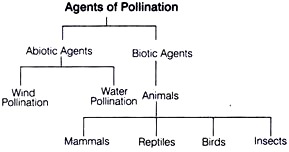ADVERTISEMENTS:
In this article we will discuss about the types and agents of pollination.
Types of Pollination:
The transfer of pollen grains from the opened anther of the stamen to the receptive stigma of the carpel/pistil is called pollination. Each pollen grain grows and provides two male gametes for fertilisation of an ovule.
Depending upon the source of pollen grain, pollination is of three types:
ADVERTISEMENTS:
1. Autogamy (Self-pollination):
It is the kind of pollination in which the pollen from the anthers of a flower is transferred to the stigma of the same flower, e.g., wheat, rice, pea, etc.
Autogamy is further classified as:
(i) Cleistogamy In some plants, flowers never open up and the anthers dehisce inside these closed flowers to ensure pollination. Thus, cleistogamous flowers are invariably autogamous as there is no chance of cross-pollination. These flowers produce assured seed sets even in the absence of pollinators, e.g., Oxalis, Viola, etc.
ADVERTISEMENTS:
(ii) Homogamy In this method, both the anthers and the stigma mature at the same time, e.g., Mirabilis.
2. Geitonogamy:
It is a kind of pollination where the pollen grains from the anther of the flower are transferred to the stigma of another flower borne on the same plant but at different branches. It usually occurs in plants, which show monoecious condition, e.g., Cucurbita.
3. Xeno-gamy (Cross-Pollination):
It involves the transfer of pollen grains from the flower of one plant to the stigma of the flower of another plant. This is the only type of pollination which brings genetically different types of pollen grains to the stigma during pollination, e.g., papaya, maize, etc.
Agents of Pollination:
The agents responsible for pollination in angiosperms have been grouped into two main categories.
Adaptations for Wind Pollination:
Wind pollination is also termed as anemophily and takes place through the wind.
ADVERTISEMENTS:
i. Flowers are small, colourless, inconspicuous, nectar less and become arranged as inflorescence.
ii. The anthers are well exposed for the easy dispersal of pollen grains.
iii. Pollen grains are small, light, dry, dusty, non-sticky and sometimes even winged.
iv. The stigmas are large, hairy and feathery or branched to catch the air borne pollen grains.
ADVERTISEMENTS:
v. Common examples of wind pollinated flowers are grass, sugarcane, bamboo and coconut, etc.
Adaptations for Water Pollination:
Water pollination is also termed as hydrophily and mode of pollination is water. It is quite rare in flowering plants and is limited to about 30 genera, mostly monocotyledons.
i. It is very common in plant groups such as algae, bryophytes and pteridophytes. Flowers are small, colourless, inconspicuous, odourless and nectar-less and pollen grains and stigmas are generally unwettable.
ADVERTISEMENTS:
ii. The stigmas are long and sticky, e.g., Vallisneria, Hydrilla and Zostera.
iii. Not all aquatic plants use water for pollination. In a majority of aquatic plants, the flowers emerge above the level of water and are pollinated by insects or winds as in land plants, e.g., water hyacinth and lily.
iv. In Vallisneria, the female flower reach the surface of water by the long stalk and pollen grains are released on to the surface of water. They are then carried by the passive water currents.
v. In most of the water pollinated species, pollen grains are protected by mucilaginous covering.
ADVERTISEMENTS:
Adaptations for Insect Pollination:
Inject pollination in also termed as entomophily.
ADVERTISEMENTS:
Insect-pollinated flowers are large, colourful, fragrant and rich in nectar.
i. A number of flowers are clustered into an inflorescence to make them conspicuous.
ii. Flowers have nectar glands and are highly fragrant to attract insects.
ADVERTISEMENTS:
iii. The surface of pollen grains is sticky due to exine layer and stigma is sticky due to mucilaginous layer.
iv. Nectar and pollen grains are floral rewards for the insect pollinators.
v. In some species, floral rewards are to provide safe place to lay eggs, e.g., for the tallest flower of Amorphophallus (about 6 feet in height).
vi. In plant Yucca, moth and the plant, cannot complete their life cycles without each other. The moth deposits its eggs in the locule of the ovary and the flower, in turn plant gets pollinated by the moth.
The larvae of the moth come out of the eggs as the seeds start developing.
Outbreeding Devices:
ADVERTISEMENTS:
Flowering plants have developed many devices to discourage self-pollination and to encourage cross-pollination. Because the majority of flowering plants produce hermaphrodite flowers and are likely to come in contact with the stigma of the same flower. The continued self-pollination leads to chances of inbreeding depression.
Devices to prevent inbreeding are:
(i) Receptivity of pollen release and stigma is not synchronized, i.e., either the pollen is released before the stigma becomes receptive or stigma becomes receptive before the release of pollen.
(ii) In some other species, the anther and stigma are placed at different positions, so that the pollen cannot come in contract with the stigma of same flower which will prevent autogamy.
(iii) Self incompatibility is the third device to prevent inbreeding, which is a genetic phenomenon of preventing inhibiting pollen tube growth on the stigma of the same flower.
(iv) Another device to avoid self-pollination is to produce unisexual flowers, i.e., autogamy is prevented, if both male and female flowers are present on same plant, e.g., castor and maize (monoecious). Both autogamy and geitonogamy is prevented in several species like papaya, if male and female flowers are present on different plants, i.e., each plant is either male or female (dioecy).

